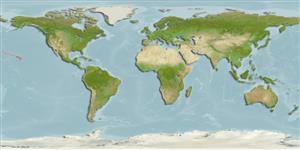>
Anguilliformes (Eels and morays) >
Ophichthidae (Snake eels) > Ophichthinae
Etymology: Callechelys: Greek, kalos, kallos = beautiful + Greek, enchelys, -yos = eel (Ref. 45335).
More on author: Snyder.
Environment: milieu / climate zone / depth range / distribution range
بوم شناسي
دريايي نزديك كف زي; تغييرات عمق 4 - 24 m (Ref. 58302). Tropical
Pacific Ocean: known only from the Hawaiian Islands, Midway Island and French Frigate Shoals.
Size / Weight / سن
Maturity: Lm ? range ? - ? cm
Max length : 104 cm TL جنس نر / بدون خواص جنسي; (Ref. 27478)
Benthic (Ref. 58302). Adults of most Callechelys spend most of their lives within the sediment and do not form permanent burrows. This species is exceptional and has on rare occasions been dip-netted beneath lights at the sea surface at night and has been seen encountered with its head protruding from the sand by divers at various Hawaiian locations (Ref. 27478).
Life cycle and mating behavior
بلوغ | تولید مثل | تخم ریزی | تخم ها | Fecundity | توزاد ( لارو)
McCosker, J.E., 1998. A revision of the snake-eel genus Callechelys (Anguilliformes: Ophichthidae) with the description of two new Indo-Pacific species and a new Callechelyin genus. Proc. Calif. Acad. Sci. 50(7):185-215. (Ref. 27478)
وضعيت در فهرست قرمز IUCN (Ref. 130435)
خطر برای انسان ها
Harmless
استفاده انسانی
اطلاعات بيشتر
اسامي عاممترادفسوخت و سازشکارچیانسم شناسي بوم زيستيتولید مثلبلوغتخم ریزیSpawning aggregationFecundityتخم هانمو تخم
Age/Size
رشد
طول - وزن
طول - طول
نوسانات طولی
ريخت ستجي بوسيله انداره گيري
ريخت شناسي
توزاد ( لارو)
پويايي لاروي
بازسازی
فراواني
BRUVS
مراجعآبزي پرورينمايه آبزي پرورينژادهاژنتيكElectrophoresesوارثبيماري هافرآوریNutrientsMass conversion
ابزارها
گزارش های ويژه
بارگيری XML
منابع اينترنتي
Estimates based on models
Preferred temperature (Ref.
123201): 24.2 - 26.4, mean 25.3 °C (based on 59 cells).
Phylogenetic diversity index (Ref.
82804): PD
50 = 0.5000 [Uniqueness, from 0.5 = low to 2.0 = high].
Bayesian length-weight: a=0.00089 (0.00039 - 0.00204), b=3.00 (2.80 - 3.20), in cm total length, based on LWR estimates for this (Sub)family-body shape (Ref.
93245).
Trophic level (Ref.
69278): 3.9 ±0.6 se; based on size and trophs of closest relatives
جهندگی (Ref.
120179): متوسط, كمينه زمان لازم براي دو برابر شدن جمعيت 4/1 – 4/4 سال (Preliminary K or Fecundity.).
Fishing Vulnerability (Ref.
59153): High vulnerability (62 of 100).
